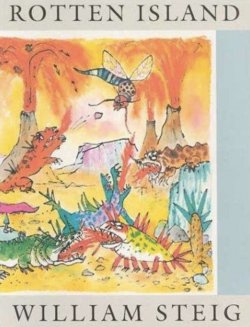Gareth B. Matthews

Review of Rotten Island by William Steig (Jaffrey, NJ: Godine, 1992). Originally published in Thinking: The Journal of Philosophy for Children 15(2): 1.
Once upon a time, there was a very unbeautiful, very rocky, and thoroughly repulsive island. The island’s volcanoes, like those of other islands, belched up fire and smoke and spewed out hot lava. In addition, these volcanoes also spat out poison arrows and two-headed toads. To be sure, there were actually plants on the island; but they were twisted, and thorny plants and they never produced any flowers at all. At night the whole island froze over and turned to ice. Each morning it had to thaw out all over again.
Set in a boiling sea of menacing and disgusting sea creatures, this rotten island made itself home to a great array of ugly monsters of every deformity and every threatening appendage imaginable. Every creature on the island was quintessentially ugly in its own special way. All these creatures adored their own ugliness and they envied the ugliness of any creature that seemed uglier than they. Nothing amused them so much as to see a fellow creature in great pain. Indeed, this rotten island was the very epitome of ugly creatures who behave in ways that match their ugly appearance.
One day, quite unexpectedly, a beautiful flower appeared on this rotten island. This flower frightened and repulsed the island’s hideous and evil inhabitants. They found it scary and upsetting. It drove them to a destructive anger and to warfare among themselves. In this way a great civil war developed in which the rotten island’s hideous creatures destroyed each other in one gigantic conflagration. That conflagration was followed by a deluge of rain and then, finally, by gentle showers. At dawn, after the rain had ended, the Rotten Island was no longer rotten. Instead, it was now ravishingly beautiful a paradise of gorgeous flowers and plants, crowned by an overarching rainbow. Soon birds came to this new island paradise. And there the story ends.
Like William Steig’s Shrek! (also recently discussed in this column) Rotten Island explores the opposition between Beauty and Ugliness, but in a different way. Shrek! calls into question conventional assumptions about the opposition between beauty and ugliness and forces us to reconsider what we consider beautiful, and why. It reminds us, to our conceptual discomfort, that some of the world’s great art depicts grotesquerie (think of the revolting scenes portrayed by Hieronymus Bosch.). Shrek! should help us think about what makes Halloween costumes and horror movies attractive to us, and perhaps especially to our children.
By contrast, Rotten Island assumes that our distinction between the beautiful and the ugly is at least reasonably well in place. It invites us to ask whether Plato and the great tradition that followed him is right in supposing that the beautiful is the enemy of evil and the cause of the good (see, for example, Plato’s dialogue, Hippias Major, at 296a) – whether perhaps the beautiful is even the very same thing as the good (see, for example the Plato’s dialogue, Symposium, at 201c).
Steig’s story is a fable. But it is also a little like the myths Plato puts in his dialogues to help make his philosophical points. Steig’s story seems to be meant to help us see some cosmic truth. It encourages us to reflect on the great battle in the world between Good and Evil and per haps to recognize the role beauty can and does play in this battle.
Many people today are certainly much more skeptical about identifying beauty in the world than Plato was. They are likely to be even more skeptical about the idea that beauty could be, like the flower in Steig’s story, a transforming force for good. And yet the idea is not totally ridiculous.
It can be instructive to ask the children around you, whether in your family or the classroom, if they can think of something that might be a little like a flower transforming a hideous and strife-plagued island into a beautiful and peaceful one. One thing that might come to their minds is the urban jungle in which so many people live today, even people in the most prosperous nations. ls it possible that planting a flower garden in a run-down housing project might affect, not only the appearance of the area, but even the way people who live there treat each other? Might beauty in a classroom, or an office, or a bus station, have any effect on the people who study or work there, and on the way, they think of themselves and treat those around them?
Steig’s story might thus prod us to take some practical action to introduce beauty into an environment that is now utterly ugly. But it may also prod us to reflect a little on the metaphysical and cosmological status of beauty. Is beauty merely a subjective and ephemeral response, something culturally induced in human beings and fixed in birds and bees only by the natural selection of biological evolution? Or is there something really out there, something, the apprehension of which may indeed be conditioned by our human culture and by the natural selection of birds and bees, but something that ideally moves us all toward the good and against evil? That is a question well worth asking, whatever our best effort at answering it turns out to be.
